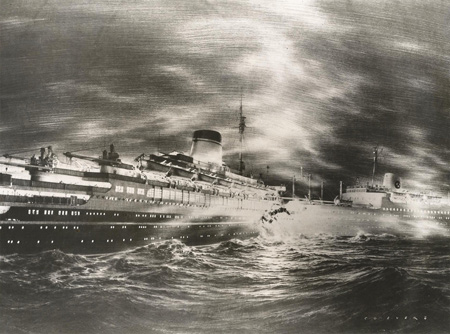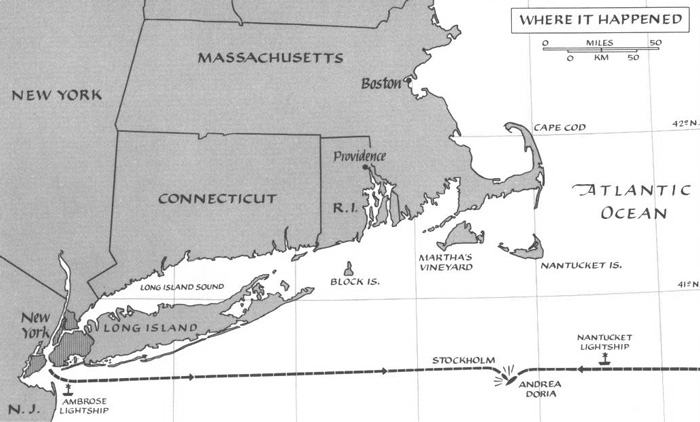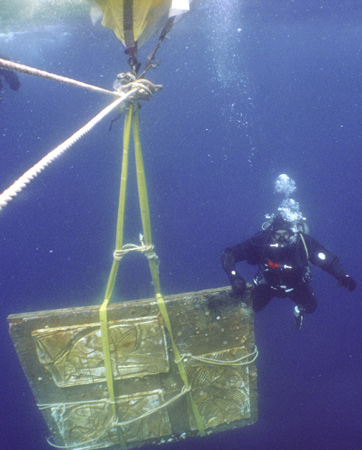Part I – Andrea Doria Was Floating Art Gallery

Stockholm collides with Andrea Doria July 25, 1956
Credit: Ellsworth Boyd Archives
The navigators of both vessels watched one another on radar, but in following international rules: “Each vessel will alter its course to starboard so that each will pass on the port side of the other,” both made unnecessary turns. Had they stayed their course, starboard to starboard, the ships would have safely passed in the night. The third mate aboard the Stockholm—en route from New York to Gothenburg, Sweden—was blamed for making the wrong turn. But the Andrea Doria, cruising in miserable conditions at close to full speed, 21.8 knots, shared the blame. With many watertight compartments, similar to the Titanic, it too was declared “unsinkable.” Nearing the end of its regular Genoa, Italy, to New York run, the luxurious Italian liner took a devastating hit on its starboard side and sank within eleven hours.

Map shows wreck site 110 miles offshore
Credit: John Moyer
Fifty-one of the 1,650 passengers and crew died on the Andrea Doria, while five perished aboard the Stockholm. Several vessels, including a U.S. Coast Guard cutter and a French ocean liner, Ile de France, aided in the rescue. With its bow smashed in like a car from a demolition derby, the Stockholm remained afloat and returned some of the survivors to New York. The three-year-old 697-foot stalwart liner—nicknamed Grand Dame of the Sea—settled on the bottom of the Atlantic Ocean, 250-feet below, 50 miles south of Nantucket, Massachusetts.
Peter Gimbel, an investment banker and heir to the Gimbel department store chain, was the first to dive the wreck 28 hours after it sank. He returned four times over the next 25 years to film and write about his fascination for one of the queens of Atlantic transportation. In 1981, he retrieved the purser’s safe, an anti-climatic endeavor that revealed some water logged bank notes and soggy Italian lire. Although disappointing, it dispelled rumors of wealthy passengers’ jewels and other treasures being stored in the safe.
East coast diver Mike de Camp renewed interest in the wreck in 1966 when he arranged charter fishing boat trips to the site for experienced divers. By the early 1980s, Captains Bill Nagle of the Seeker, Steve Bielenda of the Wahoo and Sal Arena of the Sea Hunter, offered overnight excursions, usually from mid-June through August when the weather window was best. Charters still leave from docks in New York and New Jersey. The 110 mile trip from Montauk, New York, takes 10 to 11 hours. At first, divers just wanted a glimpse of the giant silhouette resting in the sand on its starboard side, but soon they succumbed to souvenir hunting. A porthole, a china plate with “Italia” engraved on it or a light fixture retrieved from a stairwell elicited delightful conversations around coffee tables and dive club meetings. Unfortunately, in some instances, the salvage risk becomes fatal. At the time of this writing, 18 divers have lost their lives on the Andrea Doria, dubbed the “Mt Everest of Diving” for its challenges and dangers. Some of those lost were veteran divers, while others who were not as experienced pushed the envelope and became disorientated inside the wreck. There’s no defense for the dangers involved. First, divers must endure cold, dark waters accompanied by swift currents and tidal changes. Then they must avoid fishermen’s nets snagged on the wreckage and an occasional shark cruising by. Large commercial vessels also cruise by in this part of the Atlantic, a major shipping lane for years. Rough seas, fog and squalls are commonplace here. By the 1990s, most divers had replaced compressed air with trimix, a combo of helium, oxygen and nitrogen with a decompression hang-time averaging 20 minutes for a dive to 200 feet. Rebreathers are in vogue now.

John Moyer guides prized artwork to the surface
Credit: Bill Campbell
Moyer was successful, daring and smart. Before mounting his expedition, he petitioned the Federal District Court in Camden, New Jersey, for an Admiralty Arrest which gave him rights to search and salvage a specific section of the bow. After the recoveries, he returned to court and was granted clear title and ownership under Admiralty Law which governs abandoned shipwrecks in international waters. Moyer’s research had paid off revealing that although the ship was insured, no claim had ever been made. Thus the daring diver from Vineland became custodian of the lost flagship of the Italia Line. In one of the cleverest moves ever recorded in recreational diving, he had succeeded in protecting his little domain and welcomed all divers to visit other parts of his ship.
(Continued next month: What Next Grand Dame?)
Author: Ellsworth Boyd
Ellsworth Boyd, Professor Emeritus, College of Education, Towson University, Towson, Maryland, pursues an avocation of diving and writing. He has published articles and photo’s in every major dive magazine in the US., Canada, and half a dozen foreign countries. An authority on shipwrecks, Ellsworth has received thousands of letters and e-mails from divers throughout the world who responded to his Wreck Facts column in Sport Diver Magazine. When he’s not writing, or diving, Ellsworth appears as a featured speaker at maritime symposiums in Los Angeles, Houston, Chicago, Ft. Lauderdale, New York and Philadelphia. “Romance & Mystery: Sunken Treasures of the Lost Galleons,” is one of his most popular talks. A pioneer in the sport, Ellsworth was inducted into the International Legends of Diving in 2013.
10 Comments
Submit a Comment
All Rights Reserved © | National Underwater and Marine Agency
All Rights Reserved © | National Underwater and Marine Agency
Web Design by Floyd Dog Design
Web Design by Floyd Dog Design

Well written Mr. Ells. I was doing a treasure Display in Houston Texas the night the safe was opened. In an interview for the Newspaper earlier in the day a Reporter ask if there was going to a fortune come out of the Safe. I said don’t expect much, her expression told me she was disappointed, and she ask Why? My answer was The ship took almost 12 hours to sink, and did she really believe that the Purser hadn’t open it up? That night George Plimpton of Paper Lion Fame, shared the disappointment. My Friend, Steve Belinda, gave me a cup and saucer from the Doria, and I display them at shows. a small side note the Doria’s Sister Ship was, Christoff Columbo.(hope I spelled that right) was torn apart in Taiwan about 30 years ago, All of the plates, cups, glass’s ect were the same as the Dorias, and sold for 10 cents each. At least that what I was told by a friend that was bidding. Interesting stuff.
Very interesting Capt. Fizz! Thank you so much. I remember the disappointment at the opening of the safe, but as you say, the purser had lots of time to return to it before the ship sank. I didn’t know about the Andrea Doria’s sister ship being scrapped. Your cup and saucer brings back a real good story. Thanks again. Cheers, Ells
I am a 25 year fan of Clive Cussler and his Dirk Pitt novels. Recently I have started reading the NUMA files novels and they have peaked my interest. However, the Dirk Pitt novels still take a first interest with me. This is also the first time I have looked at the NUMA website and I am very impressed. Input from other members of his NUMA membership are really interesting. PLEASE CONTINUE YOUR GOOD WORK FOR OUR NATUICAL HISTORY.
Thank you very much for your kind words and support. Please pass the word on to your friends about the Numa.net site. We all love nautical history and we also strongly support protection and preservation of our oceans, lakes, rivers, streams and waterways.
Sincerely, Ellsworth Boyd, Wreckmaster
Another well written and very informative article. You may know this however, our mutual friend and wreck diver, Bart Malone, mentioned to me that he participated in, I think two dives of the Andrea Doria. If my memory is correct he was over 200 feet below.
Thank you very much for your kinds words, Harry. Yes, I knew that Bart had been on the Andrea Doria, But I didn’t know how many times. It might have been a lot more than a couple of times. And 200 feet is indeed deep. He was a great research source, helping me several times. We shall miss him. May God bless and keep dear Bart.
Maybe easier to raise the ship as its only 200 feet then to risk divers lives.
The Andrea Doria is 525 feet long. It is breaking up badly. There are some artifacts remaining, but most of them are buried in the wreckage.
My Italian grandparents traveled on the Andrea Doria the summer of 1955 from NYC bound for Italy. I visited the ship. As a 12 yr old girl, it was beautiful!
Thank you for sharing this wonderful experience. This is something you can cherish and pass on to your children and grand children. Just looking at the photo of the Andrea Doria is breathtaking. Yes, so very beautiful. It was a topnotch vessel with some of the finest artwork and beautiful designs ever embracing a passenger ship.